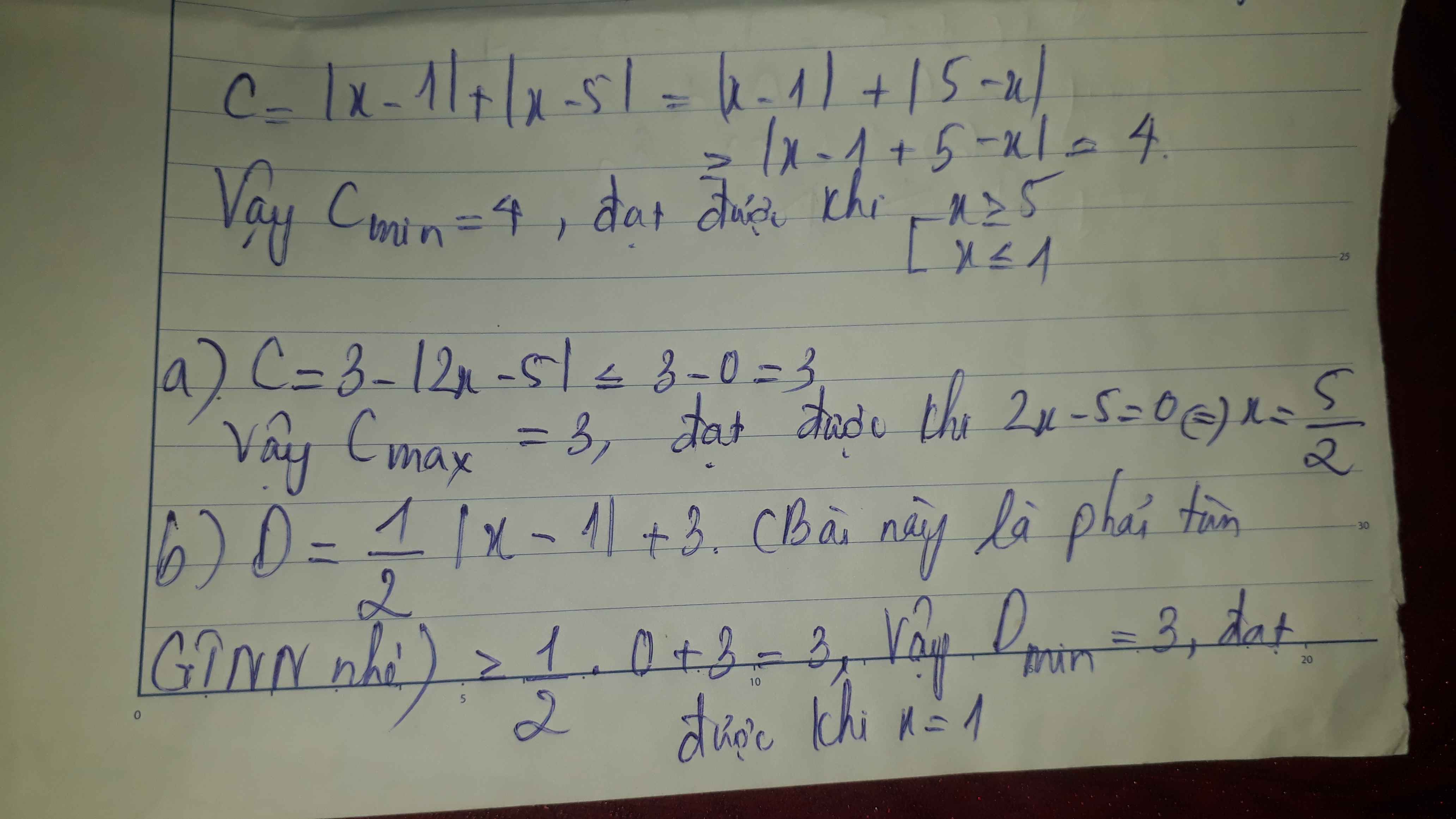Hãy nhập câu hỏi của bạn vào đây, nếu là tài khoản VIP, bạn sẽ được ưu tiên trả lời.

\(A=\left|x-a\right|+\left|x-b\right|+\left|x-c\right|+\left|x-d\right|\ge0\)
Dấu ''='' xảy ra <=> x = a ; x = b ; x = c ; x = d
hay a = b = c = d = x (*)
Vậy GTNN A là 0 <=> (*)
/:là giá trị tuyệt đối đấy ạ
mọi người giải hộ mình bài này với

A)\(\left|x\right|=\left|\frac{-5}{7}\right|\Rightarrow\left|x\right|=\frac{5}{7}\)
\(\Rightarrow\orbr{\begin{cases}x=\frac{5}{7}\\x=\frac{-5}{7}\end{cases}}\)
B)Mình ko hiểu đề bài cho lắm. Sorry nha!!
\(a,|x|=|-\frac{5}{7}|\)
\(\Leftrightarrow|x|=\frac{5}{7}\)
\(\Leftrightarrow x=\pm\frac{5}{7}\)
\(\Leftrightarrow\orbr{\begin{cases}x=\frac{5}{7}\\x=-\frac{5}{7}\end{cases}}\)
\(b,x=a-\frac{4}{5}\)
\(A,\)Để X là số dương \(\Rightarrow x>0\Rightarrow a-\frac{4}{5}>0\Rightarrow a>\frac{4}{5}\)
B)Để X là số âm \(\Rightarrow x< 0\Rightarrow a-\frac{4}{5}< 0\Rightarrow a< \frac{4}{5}\)
C)Để X không phải số dương hay số âm \(\Rightarrow x=0\Rightarrow a-\frac{4}{5}=0\Rightarrow a=\frac{4}{5}\)

Bài 2:
a) Ta có: \(\left|2x-5\right|\ge0\forall x\)
\(\Leftrightarrow-\left|2x-5\right|\le0\forall x\)
\(\Leftrightarrow-\left|2x-5\right|+3\le3\forall x\)
Dấu '=' xảy ra khi \(x=\dfrac{5}{2}\)

\(a.A=\left(x-2\right)^2+\left(y+1\right)^2+1\ge1\forall x;y\) . " = " \(\Leftrightarrow x=2;y=-1\)
b.\(B=7-\left(x+3\right)^2\le7\forall x\) " = " \(\Leftrightarrow x=-3\)
c.\(C=\left|2x-3\right|-13\ge-13\forall x\) " = " \(\Leftrightarrow x=\dfrac{3}{2}\)
d.\(D=11-\left|2x-13\right|\le11\forall x\) " = " \(\Leftrightarrow x=\dfrac{13}{2}\)

Áp dụng bất đẳng thức |m|+ |n|≥ |m + n| .Dấu = xảy ra khi m,n cùng dấu
A ≥ |x − a + x − b|+ |x − c + x − d| = |2x − a − b|+ |c + d − 2x| ≥ |2x − a − b − 2x + c + d| =|c + d − a − b|
Dấu = xảy ra khi x − a và x − b cùng dấu hay(x ≤ a hoặc x ≥ b)
x − c và x − d cùng dấu hay(x ≤ c hoặc x ≥ d)
2x − a − b và c + d − 2x cùng dấu hay (x + b ≤ 2x ≤ c + d)
Vậy Min A =c+d-a-b khi b ≤ x ≤ c
~ Học tốt ~ K cho mk nha. Thank you.

\(C=\frac{2\left(x-1\right)^2+1}{\left(x-1\right)^2+2}\)
a, Ta thấy \(\left(x-1\right)^2\ge0\forall x\Rightarrow\hept{\begin{cases}2\left(x-1\right)^2+1\ge1>0\\\left(x-1\right)^2+2\ge2>0\end{cases}}\)
\(\Rightarrow C>0\forall x\)(đpcm)
b, \(C=\frac{2\left(x-1\right)^2+1}{\left(x-1\right)^2+2}=\frac{2\left(x-1\right)^2+4-3}{\left(x-1\right)^2+2}=2-\frac{3}{\left(x-1\right)^2+2}\)
\(C\in Z\Leftrightarrow2-\frac{3}{\left(x-1\right)^2+2}\in Z\)
\(\Leftrightarrow\frac{3}{\left(x-1\right)^2+2}\in Z\)Lại do \(\left(x-1\right)^2+2\ge2\)
\(\Leftrightarrow\left(x-1\right)^2+2\inƯ\left(3\right)=\left\{3\right\}\)
\(\Leftrightarrow\left(x-1\right)^2\in\left\{1\right\}\)
\(\Leftrightarrow x\in\left\{0\right\}\)
....
c, \(C=2-\frac{3}{\left(x-1\right)^2+2}\)
Ta có : \(\left(x-1\right)^2+2\ge2\Rightarrow\frac{3}{\left(x-1\right)^2+2}\le\frac{3}{2}\)
\(\Rightarrow C=2-\frac{3}{\left(x-1\right)^2+2}\ge2-\frac{3}{2}=\frac{1}{2}\)
Dấu "=" xảy ra khi \(x-1=0\Leftrightarrow x=1\)
:33
